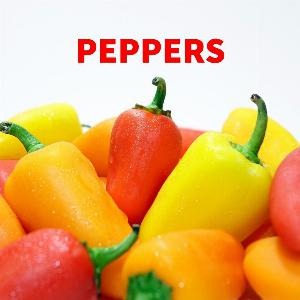Bell peppers are sweet rather than hot, to use fresh or for cooking. They are perfect for stuffing. Red bell peppers are just green bells that have been left on the vine until they turn red, although some varieties are bred for their red qualities. Golden Bells are a little milder than green bells with a wonderful sweet flavor and less bite. The Giant Marconi is a delicious pepper that is sweet, juicy, and crisp eaten fresh, or it can be used in cooking. Sweet Banana peppers are yellow and flavorful. Hot peppers range in heat from very mild to blistering. But remember, we are talking about fresh peppers – dried peppers are about ten time hotter than fresh. Starting on the mild end of the scale are Big Jim and Anaheim- hot enough to add zip, but not hot enough to scare you off. Gigante Jalapeno, Jalapeno, Mucho Nacho, Long Thin Cayenne, and Hot Hungarian Wax come next, and are getting pretty warm. The Mucho Nacho is an improved Jalapeno, identical in flavor and heat, but producing jumbo fruits, as does the Gigante Jalapeno. The Serrano pepper is about three times as hot as Jalapeno. The regular Cayenne and Super Chile are really starting to sizzle- they are six or seven times hotter than the Jalapeno or Hungarian Hot Wax. At the top of the list is the Habanero, a tiny one and a half inch, golden orange drop of fire that is
fifty to seventy times
hotter than the Jalapeno. Better be careful with that one. And then there’s the Ghost Pepper, about three times hotter than the regular habanero, and should be used exceedingly cautiously. Both hot and sweet peppers can be chopped and frozen to be used at a later time. Plant peppers close enough together so that the leaves of the mature plants just touch- they produce more that way. Don’t cultivate within a foot of the plant; use a high
phosphate
fertilizer; keep moist and mulch well. When the weather gets really hot, peppers may slow production, but will usually pick up again when it cools off.
Let's talk for a minute about peppers. . .




